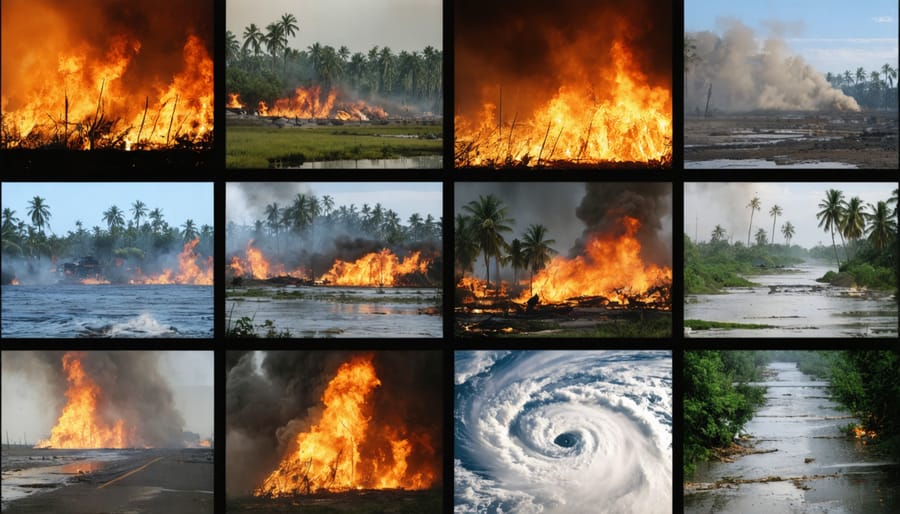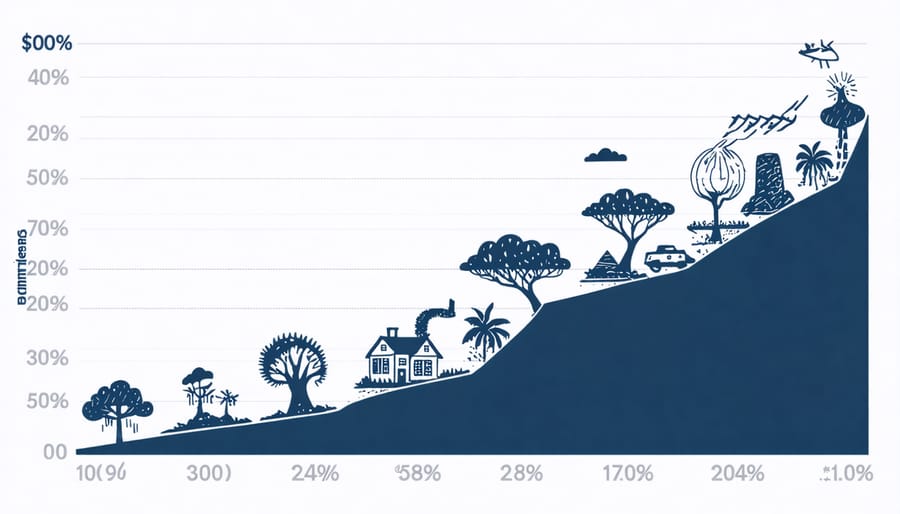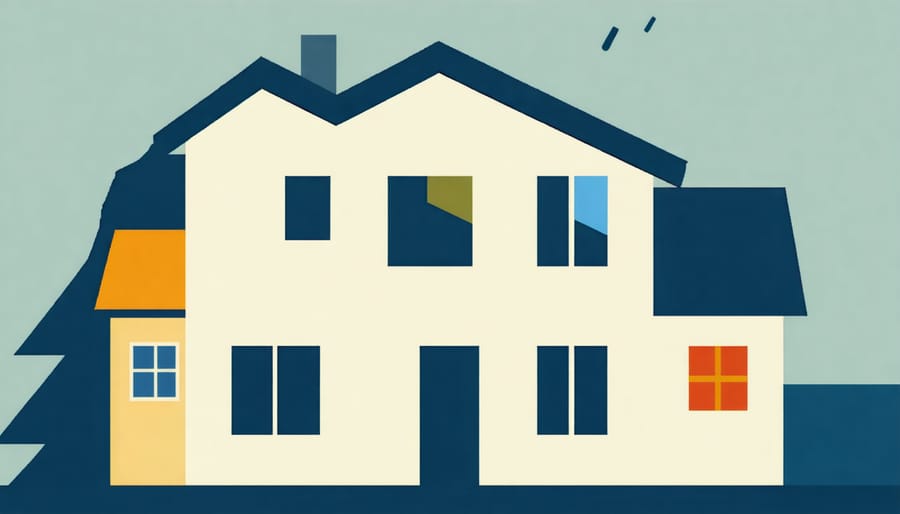The intensifying relationship between climate change and natural disasters has become a pressing concern for property owners and insurers alike, sending ripples through the real estate market. As global temperatures continue to rise, extreme weather events have surged by over 400% in the past four decades, translating into billions of dollars in property damage and skyrocketing insurance premiums.
For real estate professionals and homeowners, this new reality demands immediate attention. Coastal properties face escalating flood risks, while inland areas confront unprecedented challenges from wildfires, tornadoes, and severe storms. Insurance companies are responding by reassessing risk models, with some withdrawing coverage from high-risk areas altogether. In Florida alone, property insurance rates have jumped by an average of 42% in recent years, directly attributable to climate-related disasters.
This shift isn’t just about rising costs – it’s reshaping how we approach property ownership and investment. Understanding the intersection of climate science and real estate has become essential for making informed decisions about property acquisition, insurance coverage, and risk management. As we navigate this changing landscape, the need for adaptive strategies and innovative insurance solutions has never been more critical.
The Rising Frequency of Climate-Related Disasters

Key Natural Disasters Affecting Property Insurance
Recent data shows a significant uptick in three major types of natural disasters that directly impact property insurance rates. Hurricanes have become more intense and frequent along coastal regions, with the Atlantic hurricane season consistently producing more named storms than in previous decades. Property owners must prepare for natural disasters with increasing vigilance.
Flooding events have expanded beyond traditional flood zones, affecting properties that historically faced minimal risk. Even inland areas now experience unprecedented water damage from extreme rainfall and storm surge events. This expansion has led insurers to reassess their coverage areas and risk models.
Wildfires represent the fastest-growing threat to property insurance markets, particularly in western regions. The combination of longer dry seasons and urban expansion into wildland areas has created perfect conditions for devastating fires. California alone has seen a 500% increase in acres burned annually compared to the 1970s.
These disasters don’t just strike independently – they often create compound effects. For instance, areas hit by wildfires become more susceptible to flooding and mudslides during subsequent rainy seasons, creating complex risk scenarios for insurers and property owners alike.
High-Risk Zones: The New Normal
The concept of “safe” real estate markets is rapidly evolving as climate change reshapes our understanding of risk zones. Areas once considered prime real estate locations are increasingly facing new environmental threats, forcing property stakeholders to reassess their investment strategies.
Coastal regions previously valued for their waterfront appeal now grapple with rising sea levels and intensifying storm patterns. Even inland areas, traditionally viewed as shelter from coastal concerns, face emerging risks like unprecedented flooding, wildfires, and extreme weather events. For instance, regions in Colorado and California that were once deemed low-risk have seen property insurance premiums spike due to increased wildfire threats.
This shifting landscape affects property values and insurance costs across the board. Areas like Miami-Dade County in Florida have seen insurance rates climb by 20-30% annually, while some insurers are completely withdrawing from high-risk markets. Real estate professionals must now factor these evolving risk patterns into their property valuations and investment decisions.
For property owners and investors, understanding these changing risk dynamics isn’t just about protecting assets—it’s becoming fundamental to smart real estate decision-making.
Direct Impact on Insurance Premiums
Current Premium Trends in High-Risk Areas
Insurance premiums in climate-vulnerable regions have seen unprecedented increases over the past five years, with some areas experiencing rate hikes of up to 30-40% annually. Coastal properties, particularly in hurricane-prone regions like Florida and the Carolinas, are facing the steepest increases, while areas susceptible to wildfires in California and Colorado are seeing carriers withdraw coverage altogether.
For example, homeowners in Miami-Dade County reported average premium increases of 25% in 2023, with some facing even steeper hikes. The situation has become so critical that many property owners are turning to state-backed insurance programs or exploring alternative insurance strategies for high-risk areas.
The trend extends beyond traditional high-risk zones. Previously “safe” regions are now experiencing premium spikes due to changing weather patterns. Areas with historically low flood risk are seeing new flood zone designations, leading to mandatory insurance requirements and higher costs.
Insurance companies are responding by implementing more sophisticated risk assessment models that factor in climate change projections. This has resulted in more granular pricing based on specific property characteristics and location-based risk factors. Some insurers now offer premium discounts for properties with climate-resilient features, such as impact-resistant roofing or elevated foundations, providing a potential pathway for homeowners to manage rising costs.

Insurance Company Response Strategies
Insurance companies are actively evolving their strategies to address the mounting challenges posed by climate-related disasters. Many insurers are implementing sophisticated risk assessment models that incorporate climate change projections, leading to more nuanced policy pricing and coverage terms.
A significant trend among insurers is the introduction of resilience-based pricing, where properties with climate-adaptive features receive preferential rates. These features might include impact-resistant roofing, flood barriers, or enhanced drainage systems. Some companies are even offering incentives for homeowners who upgrade their properties with climate-resilient improvements.
However, in high-risk areas, insurers are becoming more selective about coverage. Many are limiting their exposure by increasing deductibles, capping coverage amounts, or in extreme cases, withdrawing from certain geographic markets altogether. This has led to the emergence of specialized insurance products and the growing importance of state-backed insurance programs.
To manage their risk portfolios, insurance companies are also partnering with climate scientists and data analytics firms. These collaborations help develop more accurate risk predictions and identify vulnerable areas before disaster strikes. Some insurers are taking it a step further by offering preventive services, such as property inspections and customized risk mitigation recommendations.
For property owners, this shifting landscape means staying informed about their insurance options and being proactive about implementing risk-reduction measures has become more critical than ever.
Property Owner Protection Strategies

Risk Mitigation Improvements
Implementing strategic property modifications can significantly reduce insurance premiums while protecting your investment against climate-related risks. Smart landscaping choices, such as creating defensible spaces and installing proper drainage systems, can lower insurance costs in wildfire-prone and flood-susceptible areas.
One of the most effective improvements is upgrading your roof. Impact-resistant roofing materials can earn you substantial insurance discounts, particularly in regions experiencing increased hail and severe storms. Similarly, storm shutters and reinforced windows can reduce premiums by up to 15% in hurricane-prone areas.
Installing smart water detection systems and backup sump pumps can prevent costly water damage and qualify for premium reductions. Many insurers offer discounts for homes equipped with automatic water shut-off devices, which can prevent catastrophic indoor flooding.
For coastal properties, elevating structures above base flood elevation levels can dramatically reduce flood insurance costs. Additionally, installing hurricane straps and reinforced garage doors can improve wind resistance and lead to better insurance rates.
Modern fire-resistant siding and ember-proof vents are becoming increasingly valuable in wildfire-prone regions. These improvements not only protect your property but can also result in significant insurance savings.
Remember to document all improvements with photographs and receipts, as insurers typically require proof of modifications to apply discounts. It’s also worth consulting with local building professionals who understand regional climate risks and can recommend the most cost-effective improvements for your specific situation. Regular maintenance and updates to these modifications ensure continued insurance benefits while protecting your property’s value.
Alternative Insurance Options
As natural disasters become more frequent and severe, property owners are exploring diverse climate resilience insurance options beyond traditional coverage. Parametric insurance has emerged as an innovative solution, offering quick payouts based on predefined triggers like wind speed or rainfall amounts, rather than waiting for damage assessment.
Community-based insurance pools are gaining traction, particularly in high-risk areas. These programs allow property owners to share risks and resources, potentially reducing individual premium costs while maintaining comprehensive coverage. Some communities have successfully implemented these models, resulting in more stable rates and broader protection.
Private flood insurance has become increasingly relevant as an alternative to the National Flood Insurance Program (NFIP). These policies often offer higher coverage limits and more flexible terms, though availability varies by region. Some insurers now provide hybrid policies that combine traditional coverage with catastrophe bonds, offering enhanced protection against specific climate-related risks.
Self-insurance through captive insurance companies is another option for larger property portfolios or real estate investment groups. This approach allows organizations to maintain greater control over their coverage while potentially reducing long-term costs. Additionally, some insurers offer green building coverage endorsements, which provide extra protection for environmentally sustainable features and can include upgrades to more resilient materials after a loss.
Microinsurance products are also emerging, offering smaller, more affordable coverage options for specific perils. These targeted policies can help property owners maintain essential protection while managing costs in challenging market conditions.
Future Outlook and Recommendations
Expected Insurance Market Changes
The future of home insurance is undergoing dramatic changes as climate risks intensify. Insurance companies are reassessing their coverage models, with many experts predicting significant shifts in availability and pricing across various regions.
Property owners in high-risk areas can expect to see substantial premium increases, with some analysts forecasting rises of 30-50% over the next decade. More concerning is the potential emergence of “insurance deserts” – locations where traditional coverage becomes either unavailable or prohibitively expensive due to elevated climate risks.
Insurance providers are likely to implement more stringent requirements for coverage, including mandatory climate-resilient home improvements and stricter building codes. We’re also seeing the rise of parametric insurance products, which provide predetermined payouts based on specific trigger events rather than actual damage assessments.
The market is expected to shift toward a more dynamic pricing model, where premiums adjust based on real-time climate data and risk assessments. This could lead to the widespread adoption of smart home monitoring systems and climate-adaptive technologies as ways to secure better rates.
For property investors and homeowners, these changes signal the importance of considering climate resilience in their investment decisions. Some may need to explore alternative risk-management strategies, such as self-insurance pools or community-based insurance programs, to maintain affordable coverage in the years ahead.
Long-term Planning Strategies
Property owners can take several proactive steps to protect their investments against the increasing risks of climate-related natural disasters. Start by conducting a thorough climate vulnerability assessment of your property, identifying specific risks such as flooding, wildfires, or severe storms based on your location.
Consider implementing structural improvements that enhance resilience. This might include installing hurricane-resistant windows, reinforcing roof structures, or upgrading drainage systems. While these modifications require upfront investment, they often lead to reduced insurance premiums and better property protection.
Creating a comprehensive disaster response plan is crucial. Document all valuable assets, maintain digital copies of important property documents, and establish clear evacuation procedures. Consider setting up an emergency fund specifically for disaster-related repairs and insurance deductibles.
Smart landscaping can serve as a natural defense system. Strategic placement of native plants can help control erosion, while proper grading can direct water away from structures. In fire-prone areas, maintaining defensible space around buildings is essential.
Insurance optimization is key to long-term protection. Review your coverage annually, considering riders for specific climate risks relevant to your area. Many insurers offer discounts for properties with climate-resilient features, so document all improvements and safety measures.
Finally, stay informed about local climate action plans and zoning changes, as these can affect property values and insurance rates. Joining local property owner associations can provide valuable insights and collective bargaining power for insurance rates.
Climate change’s intensifying impact on natural disasters presents significant challenges for property owners and real estate professionals, but understanding these risks empowers us to take meaningful action. The increasing frequency and severity of extreme weather events directly affect property values, insurance premiums, and long-term investment strategies in the real estate market.
To protect your real estate investments and manage rising costs, consider implementing these immediate steps: First, conduct a thorough climate risk assessment of your properties, focusing on location-specific vulnerabilities. Second, upgrade your properties with climate-resilient features, such as storm-resistant windows or improved drainage systems. Third, review and update your insurance coverage annually to ensure adequate protection against emerging climate-related risks.
For real estate professionals, staying informed about climate change impacts is no longer optional—it’s essential for business sustainability. Develop relationships with insurance providers who understand climate risks and can offer innovative coverage solutions. Consider incorporating climate risk analyses into your property evaluations and client consultations.
Remember, while the challenges are significant, they’re not insurmountable. By taking proactive measures now, you can better protect your investments and adapt to changing conditions. The key is to remain informed, prepared, and strategic in your approach to climate-related risks while maintaining a long-term perspective on real estate investments and property management.